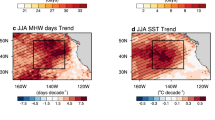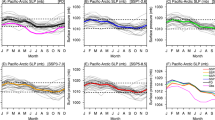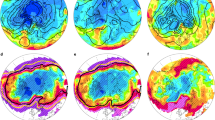Abstract
Arctic warming has sparked a growing interest because of its possible impacts on mid-latitude climate1,2,3,4,5. A number of unusually harsh cold winters have occurred in many parts of East Asia and North America in the past few years2,6,7, and observational and modelling studies have suggested that atmospheric variability linked to Arctic warming might have played a central role1,3,4,8,9,10,11. Here we identify two distinct influences of Arctic warming which may lead to cold winters over East Asia or North America, based on observational analyses and extensive climate model results. We find that severe winters across East Asia are associated with anomalous warmth in the Barents–Kara Sea region, whereas severe winters over North America are related to anomalous warmth in the East Siberian–Chukchi Sea region. Each regional warming over the Arctic Ocean is accompanied by the local development of an anomalous anticyclone and the downstream development of a mid-latitude trough. The resulting northerly flow of cold air provides favourable conditions for severe winters in East Asia or North America. These links between Arctic and mid-latitude weather are also robustly found in idealized climate model experiments and CMIP5 multi-model simulations. We suggest that our results may help improve seasonal prediction of winter weather and extreme events in these regions.
This is a preview of subscription content, access via your institution
Access options
Subscribe to this journal
Receive 12 print issues and online access
$259.00 per year
only $21.58 per issue
Buy this article
- Purchase on Springer Link
- Instant access to full article PDF
Prices may be subject to local taxes which are calculated during checkout




Similar content being viewed by others
References
Francis, J. A. & Vavrus, S. J. Evidence for a wavier jet stream in response to rapid Arctic warming. Environ. Res. Lett. 10, 014005 (2015).
Wallace, J. M., Held, I. M., Thompson, D. W., Trenberth, K. E. & Walsh, J. E. Global warming and winter weather. Science 343, 729–730 (2014).
Outten, S. D. & Esau, I. A link between Arctic sea ice and recent cooling trends over Eurasia. Climatic Change 110, 1069–1075 (2012).
Screen, J. A. & Simmonds, I. Amplified mid-latitude planetary waves favour particular regional weather extremes. Nature Clim. Change 4, 704–709 (2014).
Cohen, J. et al. Recent Arctic amplification and extreme mid-latitude weather. Nature Geosci. 7, 627–637 (2014).
Van Oldenborgh, G. J., Haarsma, R., De Vries, H. & Allen, M. R. Cold extremes in North America vs. mild weather in Europe: The winter of 2013–14 in the context of a warming world. Bull. Am. Meteorol. Soc. 96, 707–714 (2015).
Wang, L. & Chen, W. The East Asian winter monsoon: Re-amplification in the mid-2000s. Chin. Sci. Bull. 59, 430–436 (2014).
Kim, B. M. et al. Weakening of the stratospheric polar vortex by Arctic sea-ice loss. Nature Commun. 5, 4646 (2014).
Tang, Q. H., Zhang, X. J., Yang, X. H. & Francis, J. A. Cold winter extremes in northern continents linked to Arctic sea ice loss. Environ. Res. Lett. 8, 014036 (2013).
Screen, J. A. & Simmonds, I. Exploring links between Arctic amplification and mid-latitude weather. Geophys. Res. Lett. 40, 959–964 (2013).
Honda, M., Inoue, J. & Yamane, S. Influence of low Arctic sea-ice minima on anomalously cold Eurasian winters. Geophys. Res. Lett. 36, L08707 (2009).
Hartmann, D. L. et al. in Climate Change 2013: The Physical Science Basis (eds Stocker, T. F. et al.) 159–254 (IPCC, Cambridge Univ. Press, 2013).
Simmonds, I. Comparing and contrasting the behaviour of Arctic and Antarctic sea ice over the 35-year period 1979–2013. Ann. Glaciol. 56, 18–28 (2015).
Cohen, J. L., Furtado, J. C., Barlow, M., Alexeev, V. A. & Cherry, J. E. Asymmetric seasonal temperature trends. Geophys. Res. Lett. 39, L04705 (2012).
Francis, J. A. & Vavrus, S. J. Evidence linking Arctic amplification to extreme weather in mid-latitudes. Geophys. Res. Lett. 39, L06801 (2012).
Petoukhov, V. & Semenov, V. A. A link between reduced Barents–Kara sea ice and cold winter extremes over northern continents. J. Geophys. Res. 115, D21111 (2010).
Liu, J., Curry, J. A., Wang, H., Song, M. & Horton, R. M. Impact of declining Arctic sea ice on winter snowfall. Proc. Natl Acad. Sci. USA 109, 4074–4079 (2012).
Inoue, J., Hori, M. E. & Takaya, K. The Role of Barents Sea ice in the wintertime cyclone track and emergence of a warm-Arctic cold-Siberian anomaly. J. Clim. 25, 2561–2568 (2012).
Screen, J. A., Deser, C., Simmonds, I. & Tomas, R. Atmospheric impacts of Arctic sea-ice loss, 1979–2009: Separating forced change from atmospheric internal variability. Clim. Dynam. 43, 333–344 (2013).
Fischer, E. M. & Knutti, R. Heated debate on cold weather. Nature Clim. Change 4, 537–538 (2014).
Mori, M., Watanabe, M., Shiogama, H., Inoue, J. & Kimoto, M. Robust Arctic sea-ice influence on the frequent Eurasian cold winters in past decades. Nature Geosci. 7, 869–873 (2014).
Deser, C., Tomas, R., Alexander, M. & Lawrence, D. The seasonal atmospheric response to projected Arctic Sea ice loss in the late twenty-first century. J. Clim. 23, 333–351 (2010).
Overland, J. E., Wood, K. R. & Wang, M. Y. Warm Arctic-cold continents: Climate impacts of the newly open Arctic Sea. Polar Res. 30, 15787 (2011).
Hopsch, S., Cohen, J. & Dethloff, K. Analysis of a link between fall Arctic sea ice concentration and atmospheric patterns in the following winter. Tellus A 64, 18624 (2012).
Scaife, A. A. et al. Skillful long-range prediction of European and North American winters. Geophys. Res. Lett. 41, 2514–2519 (2014).
Budikova, D. Role of Arctic sea ice in global atmospheric circulation: A review. Glob. Planet. Change 68, 149–163 (2009).
Dee, D. P. et al. The ERA-Interim reanalysis: Configuration and performance of the data assimilation system. Q. J. R. Meteorol. Soc. 137, 553–597 (2011).
Takaya, K. & Nakamura, H. Geographical dependence of upper-level blocking formation associated with intraseasonal amplification of the Siberian high. J. Atmos. Sci. 62, 4441–4449 (2005).
Zhang, Y., Sperber, K. R. & Boyle, J. S. Climatology and interannual variation of the East Asian Winter Monsoon: Results from the 1979–95 NCEP/NCAR Reanalysis. Mon. Weath. Rev. 125, 2605–2619 (1997).
Sato, K., Inoue, J. & Watanabe, M. Influence of the Gulf Stream on the Barents Sea ice retreat and Eurasian coldness during early winter. Environ. Res. Lett. 9, 084009 (2014).
Renwick, J. A. & Wallace, J. M. Relationships between North Pacific wintertime blocking, El Nino, and the PNA pattern. Mon. Weath. Rev. 124, 2071–2076 (1996).
Cowtan, K. & Way, R. G. Coverage bias in the HadCRUT4 temperature series and its impact on recent temperature trends. Q. J. R. Meteorol. Soc. 140, 1935–1944 (2014).
Acknowledgements
J.-S.K. was supported by National Research Foundation (NRF-2014R1A2A2A01003827). J.-H.J. was supported by Korea Polar Research Institute project (PE15010). B.-M.K. was supported by Korea Meteorological Administration Research and Development Program (KMIPA2015-2093). C.K.F. was supported by the Joint UK DECC/Defra Met Office Hadley Centre Climate Programme (GA01101).
Author information
Authors and Affiliations
Contributions
J.-S.K. and J.-H.J. designed the research, conducted analyses, and wrote the majority of the manuscript content. B.-M.K., C.K.F., S.-K.M. and S.-W.S. conducted the analysis and report-writing tasks. Y.-S.J. conducted analyses, numerical experiments and prepared figures. All the authors discussed the study results and reviewed the manuscript.
Corresponding author
Ethics declarations
Competing interests
The authors declare no competing financial interests.
Supplementary information
Supplementary Information
Supplementary Information (PDF 2617 kb)
Rights and permissions
About this article
Cite this article
Kug, JS., Jeong, JH., Jang, YS. et al. Two distinct influences of Arctic warming on cold winters over North America and East Asia. Nature Geosci 8, 759–762 (2015). https://doi.org/10.1038/ngeo2517
Received:
Accepted:
Published:
Issue Date:
DOI: https://doi.org/10.1038/ngeo2517
This article is cited by
-
Response of winter climate and extreme weather to projected Arctic sea-ice loss in very large-ensemble climate model simulations
npj Climate and Atmospheric Science (2024)
-
The warm Arctic-cold north american pattern in CanESM5 large ensemble simulations: Eurasian influence and uncertainty due to internal variability
Climate Dynamics (2024)
-
Relative Impacts of Sea Ice Loss and Atmospheric Internal Variability on the Winter Arctic to East Asian Surface Air Temperature Based on Large-Ensemble Simulations with NorESM2
Advances in Atmospheric Sciences (2024)
-
Ocean fronts as decadal thermostats modulating continental warming hiatus
Nature Communications (2023)
-
Arctic-associated increased fluctuations of midlatitude winter temperature in the 1.5° and 2.0° warmer world
npj Climate and Atmospheric Science (2023)



